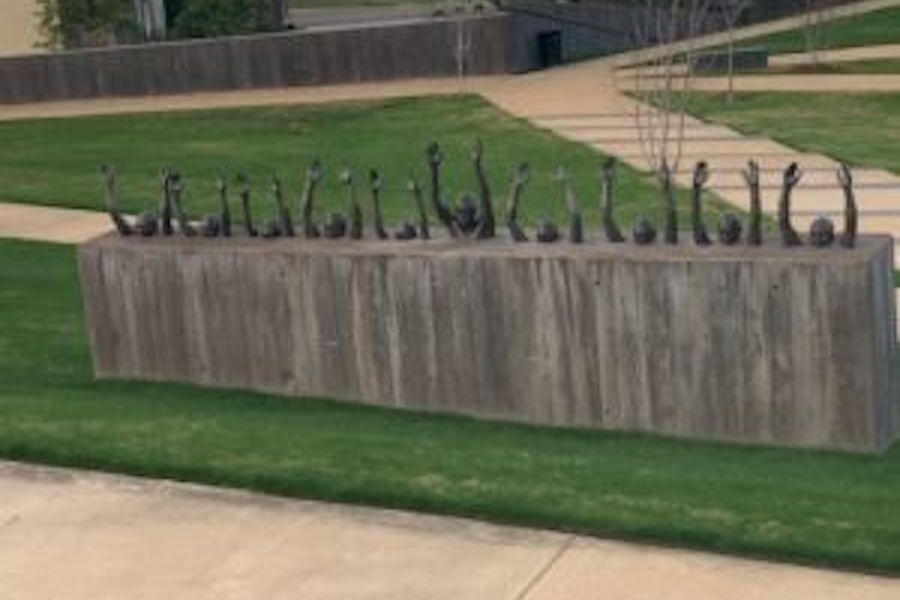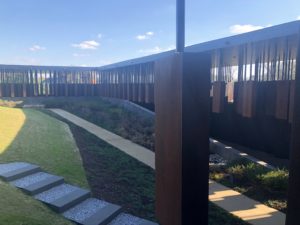Reflecting on Injustice and Recommitting to Equity

This February, as we celebrate the historical contributions of giants like Martin Luther King Jr., Thurgood Marshall, and Rosa Parks, we must also remember the systems they endured, and the innumerable black and brown people whose lives were lost in the fight for equality.
When Executive Director of the St. Louis Promise Zone Erica Henderson traveled to the National Memorial for Peace and Justice in mid-January, she became reinvigorated by a history that governs her work for racial equity in the St. Louis Promise Zone today.
“As I further my work in the social justice space, having read the book Just Mercy, I wanted to go see this work—the Legacy Museum and the Peace and Justice Memorial,” said Henderson. “I spent two days taking it all in … It gave me renewed commitment and determination for my purpose, for this time, and for this work.”
Opened in April 2018 by Bryan Stevenson’s Equal Justice Initiative, the National Memorial for Peace and Justice is “the nation’s first memorial dedicated to the legacy of enslaved black people, people terrorized by lynching, African Americans humiliated by racial segregation and Jim Crow, and people of color burdened with contemporary presumptions of guilt and police violence,” according to the EJI website.
 The memorial is set on a six-acre site in Montgomery, Alabama, the former “cradle of the confederacy.” Surrounding the central “memorial square” are fields strewn with designs that force you to confront America’s history of racial injustice—sculptures of enslaved men and women in shackles, an invocation to victims of racial violence, a row of black men frozen in cement with their hands up.
The memorial is set on a six-acre site in Montgomery, Alabama, the former “cradle of the confederacy.” Surrounding the central “memorial square” are fields strewn with designs that force you to confront America’s history of racial injustice—sculptures of enslaved men and women in shackles, an invocation to victims of racial violence, a row of black men frozen in cement with their hands up.
A gravel path guides you through these sculptures and into the large pavilion at the center of the site. Inside, you walk through rows of 6-foot-tall Corten steel slabs, each of which is inscribed with the name of a U.S. state or county, along with the names of the victims of racial terror lynchings reported in that area between 1877 and 1950. There are over 4,300 names on 800 steel monuments. As you walk, the ground very gradually descends beneath you, until the steel slabs that you walked among are suspended above you—hanging brown figures, lifeless in each other’s shadows.
Those names, those memories, are the reasons the Promise Zone exists, said Promise Zone VISTA Trevaughn Latimer, who also recently visited the memorial.
“We tend to remember things that happened in our lifetime, and we never really intentionally look past our lifetimes,” said Latimer. “But everything has a context. Everything has history. The need for economic development in very specific areas around St. Louis is because of a history of racism.”
Both Latimer and Henderson have returned to their daily work in the St. Louis Promise Zone with a new commitment in 2020, driven by their memories of the memorial.
Latimer remembers a hologram of a black woman in a jail cell singing a familiar song. It reminded him of his family. He could hear them singing, too, the past and present indelibly linked.
Henderson remembers an exhibit in the memorial’s sister site, the Legacy Museum, which depicted a slave auction. The enslaved man on the block shared her last name.
“Sometimes you have to go back and reflect to recommit yourself to the work … It’s my intention to prioritize the advancement of racial equity and systems work for the future, but you have to understand historical context before you know where you’re going,” said Henderson. “It’s a reminder that there is still so much work to do, and one organization cannot do it alone. It takes everyone doing their part to get where we need to be.
“For the hanged and beaten. For the shot, drowned, and burned. For the tortured, tormented, and terrorized. For those abandoned by the rule of law. We will remember. With hope because hopelessness is the new enemy of justice. With courage because peace requires bravery. With persistence because justice is a constant struggle. And with faith because we shall overcome.” – Inscription at the National Memorial for Peace and Justice
Learn more about the Equal Justice Initiative at eji.org.
Read the Equal Justice Initiative’s full report on lynching in America here: https://lynchinginamerica.eji.org/report/
